Thin layer chromatography Study guides, Class notes & Summaries
Looking for the best study guides, study notes and summaries about Thin layer chromatography? On this page you'll find 216 study documents about Thin layer chromatography.
Page 4 out of 216 results
Sort by
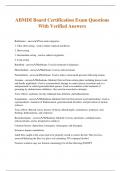
-
ABMDI Board Certification Exam Questions With Verified Answers
- Exam (elaborations) • 18 pages • 2024
-
- $12.49
- + learn more
ABMDI Board Certification Exam Questions With Verified Answers Barbituates - answerFour main categories: 1. Ultra-short-acting - used to induce surgical anesthesia 2. Short-acting 3. Intermediate-acting - used as sedative-hypnotics 4. Long-acting Butalbital - answerBarbituate. Used in treatment of migraines. Phenobarbital - answerBarbituate. Used as anticonvulsant. Pentobarbital - answerBarbituate. Used to relieve intracranial pressure following trauma. Atropine - answerBelladonna Alka...
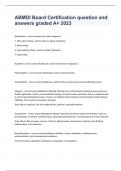
-
ABMDI Board Certification question and answers graded A+ 2023
- Exam (elaborations) • 20 pages • 2023
- Available in package deal
-
- $17.99
- + learn more
ABMDI Board Certification question and answers graded A+ 2023 Barbiturates - correct answer Four main categories: 1. Ultra-short-acting - used to induce surgical anesthesia 2. Short-acting 3. Intermediate-acting - used as sedative-hypnotics 4. Long-acting Butalbital - correct answer Barbituate. Used in treatment of migraines. Phenobarbital - correct answer Barbituate. Used as anticonvulsant. Pentobarbital - correct answer Barbituate. Used to relieve intracranial pressure following ...
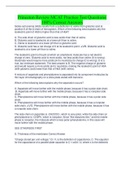
-
Princeton Review MCAT Practice Test Questions| 100% Correct Answers
- Exam (elaborations) • 45 pages • 2023
-
- $13.49
- + learn more
Princeton Review MCAT Practice Test Questions| 100% Correct Answers Sickle-cell anemia (HbS) results from a substitution to valine from glutamic acid at position 6 of the β chain of hemoglobin. Which of the following best explains why the isoelectric point of HbS is higher than that of HbA? A. The side chain of glutamic acid is less acidic than that of valine. B. Glutamic acid is isoelectric at a lower pH than is valine. C. Valine is isoelectric at a lower pH than is glutamic acid. D. G...
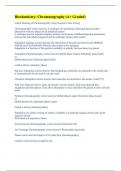
-
Biochemistry: Chromatography (A+ Graded)
- Exam (elaborations) • 11 pages • 2023
-
- $10.39
- + learn more
Literal Meaning of Chromatogrpahy correct answers Color writing Chromatography correct answers A technique for separating compounds based on their interaction with two phases of an analytical system A technique used to separate complex mixtures on the basis of different physical interactions between the individual compound and the stationary phase of the system Separation Function correct answers The interaction of the particles between the MOBILE PHASE and STATIONARY PHASE allows them to...
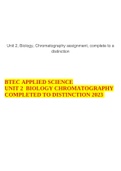
-
BTEC APPLIED SCIENCE UNIT 2 BIOLOGY CHROMATOGRAPHY COMPLETED TO DISTINCTION 2023
- Exam (elaborations) • 7 pages • 2023
-
- $10.49
- + learn more
BTEC APPLIED SCIENCE UNIT 2 BIOLOGY CHROMATOGRAPHY COMPLETED TO DISTINCTION 2023 Chromatography The term chromatography can be described as a technique used to separate the compounds within a mixture (or solutes), determined by the relative proportions of each solute distributed between a moving fluid stream, which is called the mobile phase, as well as a stationary phase which could be potentially contiguous. The stationary phase might be in the form of a solid or a liquid whereas duri...
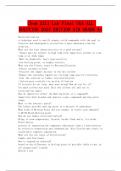
-
Chem 2211 Lab Final UGA ALL SOLUTION 2023 EDITION AID GRADE A+
- Exam (elaborations) • 7 pages • 2023
-
- $11.39
- + learn more
Recapitalization a technique used to purify organic solid compounds with the goal to dissolve and subsequently crystallize a pure substance from the solution. What are the four characteristics of a good solvent? -Target must be soluble in high temp with impurities soluble at room temp or at high temps -Must be chemically inert (non-reactive) -Low boiling point, or highly volatile What are the 5 basic steps to Recrystallization -Choose suitable solvent -Dissolve the impure mixture in the...
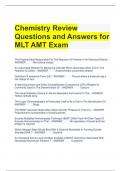
-
Chemistry Review Questions and Answers for MLT AMT Exam
- Exam (elaborations) • 8 pages • 2023
- Available in package deal
-
- $12.89
- + learn more
Chemistry Review Questions and Answers for MLT AMT Exam The Property Most Responsible For The Migration Of Proteins In An Electrical Field Is: - ANSWER Net surface charge An Automated Method For Measuring Chloride Which Generates Silver Ions In The Reaction Is Called: - ANSWER Amperiometric-coulometric titration Definition Of Isoelectric Point (pl)? - ANSWER The pH where a molecule has a net charge of zero 8-Hydroxyquinoline and Ortho-Cresolphthalein Com...
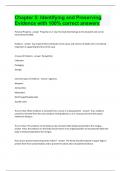
-
ABMDI Board Certification with 100% correct answers
- Exam (elaborations) • 6 pages • 2024
- Available in package deal
-
- $15.49
- + learn more
ABMDI Board Certification withBarbituates Four main categories: 1. Ultra-short-acting - used to induce surgical anesthesia 2. Short-acting 3. Intermediate-acting - used as sedative-hypnotics 4. Long-acting Butalbital Barbituate. Used in treatment of migraines. Phenobarbital Barbituate. Used as anticonvulsant. Pentobarbital Barbituate. Used to relieve intracranial pressure following trauma. Atropine Belladonna Alkaloid. Derived from certain plants including ji...
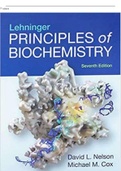
-
Test Bank: Lehninger Principles of Biochemistry, 7th Edition, David L. Nelson (Complete Download) . All Chapters 1-28
- Exam (elaborations) • 648 pages • 2022
-
- $15.59
- 1x sold
- + learn more
1. In a bacterial cell, the DNA is in the: A) cell envelope. B) cell membrane. C) nucleoid. D) nucleus. E) ribosomes. 2. A major change occurring in the evolution of eukaryotes from prokaryotes was the development of: A) DNA. B) photosynthetic capability. C) plasma membranes. D) ribosomes. E) the nucleus. 3. In eukaryotes, the nucleus is enclosed by a double membrane called the: A) cell membrane. B) nuclear envelope. C) nucleolus. D) nucleoplasm. E) nucleosome. 4. T...
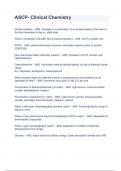
-
ASCP- Clinical Chemistry QUESTIONS & ANSWERS ( A+ GRADED 100% VERIFIED)
- Exam (elaborations) • 10 pages • 2023
- Available in package deal
-
- $9.49
- + learn more
ASCP- Clinical Chemistry QUESTIONS & ANSWERS ( A+ GRADED 100% VERIFIED) Diurnal variation - ANS Changes in concentration of an analyte based on the time of the day (measured at day vs. night time) What is increased in the AM? (b/c of diurnal variation) - ANS ACTH, Cortisol, Iron ACTH - ANS adrenocorticotropic hormone- stimulates adrenal cortex to secrete CORTISOL How does stress affect chemistry values? - ANS Increase in ACTH, cortisol, and catecholamines Catecholamines - A...



